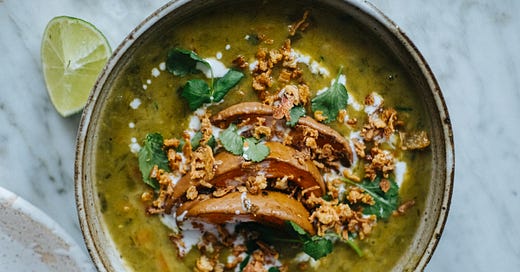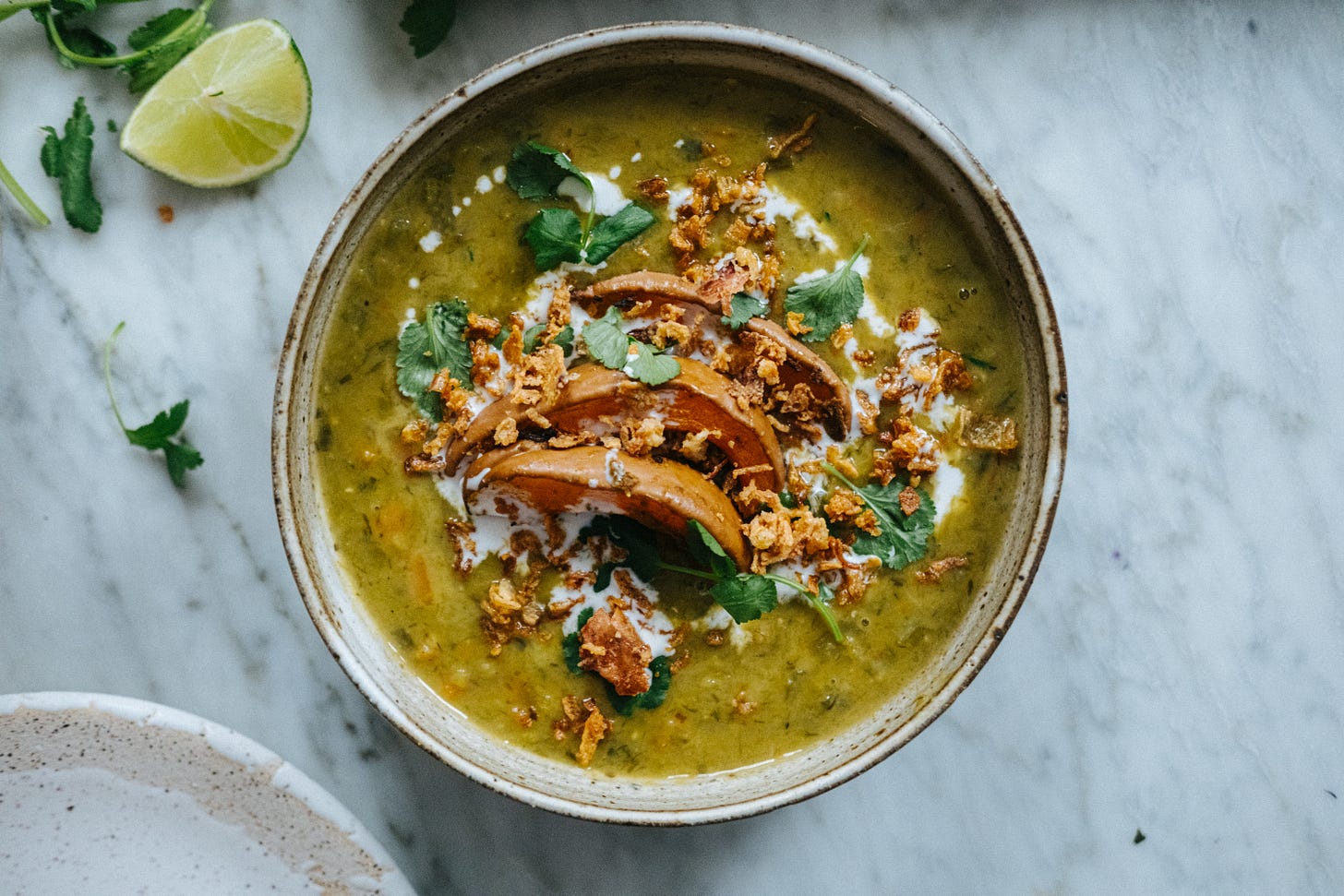Welcome to To Vegetables, With Love, a celebration of a vegetable life, less ordinary.
My book Tenderheart is available from Books are Magic, Kitchen, Arts and Letters, Book Larder, Bold Fork Books and also here or here.
The other day I asked google, are split peas a good source of protein?
Google answered,
Split peas are a great source of plant-based protein, plus they come with many additional health benefits. A 1/2 cup of cooked split peas contains about 115 calories, 8 grams of protein, and 8 grams of fiber. They are also low in fat, and a good source of folate, iron, and potassium
(source: here - in the interest of fairness, this is the first search result that came up and I have no prior knowledge of or affiliation with Food Smart Colorado.)
I actually do not enjoy the word “protein”. It is way overused here in America and every time someone wants to question or invalidate my vegetarian diet, they will say “but what about protein? How do you make sure you are eating enough protein?”
It is a question I don’t even care to answer anymore. Because, barring any health issues, if you eat a balanced vegetarian diet (aka not boxed mac and cheese every day), you should be good. In truth, there is protein in more places than we think. Modern food media and eating establishments want us to believe that protein can only be found in something that bleeds. In the plant-based world, protein sources are varied and vast. Soy products like tofu and tempeh are excellent sources of course, but don’t forget edamame beans. I often use it as the main part of my meal like this edamame bean pesto pasta.
Tempeh: 17 g protein per 1/2 cup
Shelled edamame: 9 g protein per 1/2 cup
Tofu: 9 g protein per 3 ounces
Soy milk: 7 g protein per 1 cup
Then there are my stalwarts, quinoa (8 g protein per 1 cup) and lentils (18 g per 1 cup) and chickpeas (14.5 g per 1 cup).
Potatoes too are packed with protein:
Russet: 8 g per large spud
Red: 7 g per large spud
Sweet: 2.5 g per medium spud
And why not sprinkle everything with nutritional yeast? It has 4 grams of protein per 2 tablespoons - not to mention it’s gluten free, sodium free and bloody delicious.
Protein can also be found in spinach, broccoli, asparagus, artichokes and sweet corn. As I said, we are all eating protein even when we don’t necessarily know it.
(the above protein facts were sourced from this Eating Well article)
During the week, I turn to legumes a lot as a way of creating a meal that is hearty, filling and healthy. This split pea soup is one of them. It’s not your average split pea soup. For a simple twist that yields transformative results, I add Thai curry paste and coconut milk. Thai curry paste immediately adds interest and intrigue, with deeper flavors. Remember the power of pastes in weeknight cooking; I wrote about it last year for my Plant Power II vegan newsletter for The Washington Post (you can still subscribe to it here and get 20 free recipes!). Think of pastes - tomato, gochujang, doubanjiang, harissa etc - as flavour cheats, which give you a head start in achieving bold flavours, quickly. In a jar of paste, someone else has already cooked down the garlic/onion/tomato/peppers/chilies/garlic for you, so you’re halfway closer to dinner being made.
There are many types and brands of Thai curry paste on the market and each will probably give you slightly different results so vary the amount you use according to the salty/spice level of the one you are using. I used a very commercially available Thai Kitchen brand which comes in a 4 ounce (113g) jar which is perfectly sized for this recipe.
COOK / EAT / SHARE
This week, I’m turning to my kimchi and cheese udon noodles for a quick midweek meal. Another quickie is this baby bok choy and ginger scallion rice noodles, or this vegan ceci e pepe (chickpeas and pepper) pasta. Two lighter meals could be this crispy gnocchi tomato salad or this tofu larb.
Cooking from Tenderheart: Daikons are in season in NYC, so I made my lo bak gao (“turnip paste”) in the Turnip and Daikon chapter. It’s one of the more involved recipes in Tenderheart but a fun project if you are looking to learn. I also made one of our favourite and quickest family meals - kale orzo, which is loaded with lemon, dill and feta. Also the baby bok choy soy-butter pasta because I went to chinatown and bought the freshest bag of Shanghai baby bok choy for $3. Tonight, I’m making Huck’s broccoli salad (a salad I dedicated to my youngest because he loves it).
THIS WEEK’S RECIPE
Thai curry split peas with roasted squash
© Hetty Lui McKinnon for To Vegetables, With Love
Split peas take about an hour to cook and break down. If you have time, you could soak your split peas overnight or even just for a couple of hours which means they will soften slightly faster.
If you don’t have split peas, use red lentils - it will cook much faster, closer to 30 minutes.
I’ve topped the split peas with roasted squash but you could top with any roasted veggies you like. Roasted cauliflower, broccoli, brussels sprouts or carrots would be really nice too.
Serves 4
extra virgin olive oil
2 small leeks, thinly sliced and washed
1 carrot, finely diced
1 stick celery, finely diced
sea salt and black pepper
450g (1 pound) pumpkin/squash such as koginut or butternut
About 100g / 4 ounces Thai curry paste (any colour)
2 cloves garlic, finely chopped
450g (1 1/2 cups/1 pound) green or yellow split peas
2 liters (8 cups) vegetable stock
4 makrut lime leaves, thinly sliced (optional)
400ml / 13.5 ounce (1 can) coconut milk (well shaken)
To serve
1 lime, cut into wedges
Handful coriander/cilantro leaves
Crispy fried shallots
Preheat oven to 200˚C / 400˚F.
Heat a large Dutch oven or wide pot on medium for 2 minutes. When hot, drizzle with olive oil and add the leeks, carrots and celery. Add 1 teaspoon of sea salt, season with black pepper, and cook, stirring occasionally, until softened and starting to caramelize, 8-10 minutes.
Meanwhile, slice the squash into thin 1.25cm (1/2-inch) wedges (no need to peel thin skinned squash like butternut or koginut, but you can remove skin for thicker skinned acorn, Japanese, kabocha etc). Drizzle with olive oil, season with sea salt and black pepper and add 2 teaspoons of the Thai curry paste. Toss to coat - this is easiest done with hands - and then arrange into a single layer and roast until tender and caramelized on the edges, 20-22 minutes.
To the leeks, add the garlic and the remaining 3-4 tablespoons of Thai curry paste (if your paste is spicy, you can add less) and stir until fragrant, 1-2 minutes. Add the split peas and stock and increase the heat to bring the mixture to a simmer. Reduce heat to low for a slow simmer, cover and cook until the split peas are completely tender and fall apart willingly when stirred, 45-50 minutes. Turn off the heat and stir in 1/2 cup of coconut milk and the makrut lime leaves, if using.
When ready to serve, ladle the split peas into serving bowls, drizzle with coconut milk and squeeze over some lime. Top each bowl with the roasted squash/pumpkin, some coriander/cilantro and crispy fried shallots.
If you’re looking for a newsletter recipe, see my Substack recipe archive here. For recipes with a 🔒 symbol, you will need a paid subscription. Everything else is free.
🥦 My cookbook, Tenderheart is for cooking vegetables, all year round. Pick up your copy here. It is also mostly vegan (or vegan-izable) and gluten-free adaptable.








It is so frustrating the comments and questions on vegetarians and protein! I think this is an excellent podcast which covers the whole question of protein really well for vegetarians, vegans and omnivores
https://zoe.com/learn/podcast-should-i-eat-more-protein.amp
I cannot wait to try this. I have never had split peas before. Sounds like a good staple to have in the cupboard!